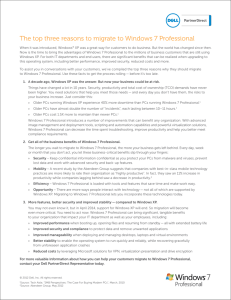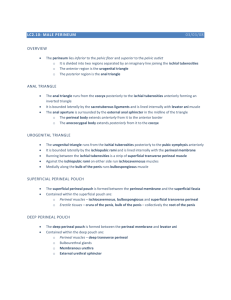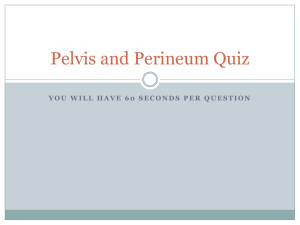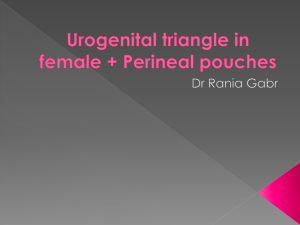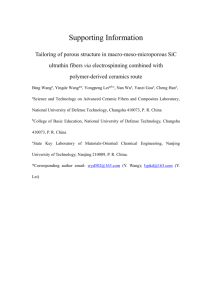Pudendal canal syndrome overview
advertisement
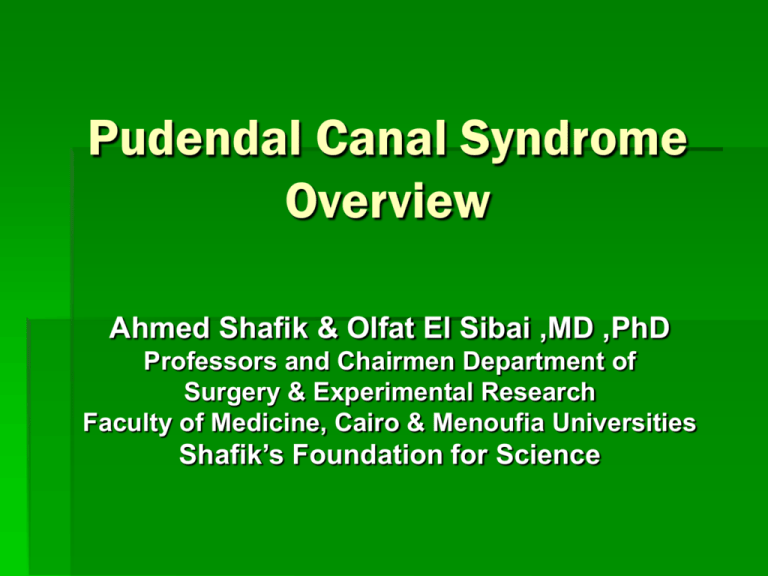
Pudendal Canal Syndrome Overview Ahmed Shafik & Olfat El Sibai ,MD ,PhD Professors and Chairmen Department of Surgery & Experimental Research Faculty of Medicine, Cairo & Menoufia Universities Shafik’s Foundation for Science Surgical anatomy of PN: (Shafik ,1995) S2 → upper cord S3 lower cord S4 PN above SPL → pass behind SPL medial to ischial spine → pass between SPL + STL→ PC → branches: *IRN * Perineal n * Dorsal n of penis (clitoris) Pudendal canal syndrome: (Shafik,1991) PN compression in PC Presentation: 1- Proctalgia (Shafik, 1991& El-Sibai, 1996) 2- FI (Shafik, 1994) 3- FI in complete R prolapse (Shafik, 1994) 4- USI (Shafik, 1994) 5- ED (Shafik, & El-Sibai, 1995) 6- Scrotalgia (Shafik, 1993) 7- Prostatodynia (Shafik, 1998) 8- Vulvudynia (Shafik, 1997) 9- Interstitial cystitils (Shafik, 2008) 10- Ischemic proctitilis (Shafik, 1996) Mechanism of PCS On ↑↑straining at defecation or delivery → ↑ intra-abd.pr. → brunt on LA & anoccygeal raphe → LA sublaxation & sagging → pull on IRN → pull on PN → neuropraxia or axontmesis → PN entrapment neuropathy in PC by edemae & ischemia → motor & sensory manfestation of PCS Proctalgia: (Shafik, 1991 & El-Sibai 1996) - Abrupt, sharp pain in anal or perianal regions - Few to 30 mts - Intermittent, by day or night - Unrelated to defecation - Aggravated by sitting - 2-3 times / wk - Increasing frequency - Perineal numibness & tingling - Common in multiparous & difficult deliveries - ±assoc. with FI to soft stools or flatus - D/E: ▪ tenderness on pressing on PN ▪ peri-anal & peri-vulval hypo. or anesthesia ▪ absent anal reflex FI: (Shafik 1994) - Females with multiple deliveries - FI to stools and flatus - alone or with SUI or in CRP - ↓ anal pr. - P. neuropathy by PCS→ IRN neurpthy. FI in CRP: 1994) (Shafik, In CRP →↓ EMG activity of LA Levator dysfunction ± primary cause of CRP Sublaxated & sagged LA → pull on PN → Continues LA activity → PN stretch & tramatization → neuropraxia or axontmesis → PN entrapment → IRN neuropathy → FI PNTML prolonged USI: (Shafik,1994) ↓ EMG activity of EUS & prolonged both latency of straining-urethral reflex & PNTML ET is neurogenic→PCS Evidences : - Weak EUS - Prolonged latency of straining- urethr. reflex - Prolonged PNTML - Concomitant idiopath. FI - ↑ USI incidence with multiparous Erectile Dysfunction: (Shafik,1994, El-Sibai,1995) ▪ Excluded psycogenic, vasculogenic, hormonal & metabolic (dibetis M) ▪ ± Assoc. with penile pain Absent nocturnal tumescence Penile, perineal & scrotal hypo. or anesthesia EMG: ↓ EUS, EAS & LA ↑ PNTML Chronic constipation & ↑↑straining at defecation→↑intra-abd. pr.→ overstretch of LA → LA sublaxation & sagging→ pull on PN & artery →entrapment→ dorsal N. of penis neuropathy→ ED Vulvudynia: (Shafik,1997) Vulvur burning & introital dyspareunia of idiopathic cause with failed various trt. Multiparous, assoc. with USI Pain every 2-3ds. induced by coitus Not related to defecation or urination Crisis 2-4hs. PN block diagnostic Gyne.exam.→bilat. vulvar erythema & tenderness on pressing on PN Valvar & perineal hyposthesia or anesthesia Beco et al, 2004 : 74 female pts. with perineodynia (vulvudynia,perineal pain & proctalgia), FI & USI PCD : - Significant improvement of symptoms & signs - ↓ PNTML - ↑ EMG activity of LA & EAS Scrotalgia:( Shafik,1993) Scrotal pain alone or ± assoc. penile pain or ED No testicular pathology (varicocele or infection) P.H. of chronic constipation & ↑↑ straining at defecation D/E: -tenderness on pressing on PN -hypo. or anesthesia of perineal area ↓ EMG of LA &EAS & ↓ PNTML Prostatodynia: (Shafik,1998) Pain in perineam & scrotum or anal canal Continuous with exacerbation or intermittent Dull aching ,not related to urination or defecation Assoc. with frequency, urgency & dysuria Prostatic secretion → no bacteria No improvement with antibiotic P.H. chronic constipation & ↑↑ straining Perineal hyposthesia & weak anal reflex EMG ↓ activity of LA & EUS, normal EAS PNTML ↑ PN block → diagnostic & therapeutic test IRN → supplies EAS,LA & m.m. of ↓1/2 of AC & perinanal skin Perineal N.→ EUS Mechanism: Constipation & straining → LA sublaxation & sagging → pull on PN → stretch distal part of PN at winding around SPligmt.→ neuropraxia & axontmesis *Subsequant N.compression → PN ischemia→N. damage *P.neuropathy involves perineal N & to a lesser extent IRN Interstitial Cystitis : (Shafik 2008) - Pain suprapubic,pubic,vaginal & genital - Exacerbated by intercourse or ejaculation - Exam. → suprapubic & vag. wall tenderness - Common in ♀ & IC most common cause of pelvic pain in gyne. - Remission & relapse - UB innervated by pelvic hypogastric/lumbar splanchnic innerv. Lumbosacral afferent in pelvic & PN sense & regulate continence & micturition - PN commonly compressed by PC or by sacral ligmts. clamp - PN entrapment → P neuritis → PCS - Painful micturition & dysparuma are symptoms of genital & perineal n. involvement of PN. Pudendal Artery Syndrome Presenting as Ischemic Proctitis Report of 3 cases (Shafik,DigSurg 1996): Not in literature Anal pain,bleeding &P.H. of stainodynia+PCS D/E→AC tender,edematous & ulcerated R &C →free Biopsy: mucosa lost,submuc.edem.& RC infiltration D :selective pudendal arteriography → obliterated distal part(PC),not visualized IRA Et :→ L sublaxation & sagging →pull on artery & nerve in→arteritis & neuropathy TRT: PCD →release PN & IPA PO : - symptoms disappear - healing of AC - IPA remains obliterated but improvement is due to release of collateral vess. From compression Diagnosis: ▪ C/E: ● P.H. of straining ● PCS symptoms ● D/E: -tenderness on pressing on PN -perianal or perineal hypo.or anesthesia ▪ ↓ AC pr. ▪ ↓ anal reflex ▪ ↓ EMG of LA & EAS or EUS ▪ ↑ PNTML Pudendal nerve decompression: Technique : Anterior approach. ▪ Lithotomy position Vertical para-anal incision 2cm from A orifice ▪ Ischio-rectal fossa entered ▪ IRN identified across IRF,N hooked by finger & traced to PN in PC ▪ PC fasciotomy ▪ Same procedure on the other side PND :Posterior app roach (Shafik,1992) Technique : Pt. in jack knife position Vertical para-sacral skin incision Glut. max. exposed & divided Triangle identified PN & vess. are over sacrospinous lig. passing from GSF to LSF PC fasciotomy & PN releasad Glut. Max. repaired Op. repeated on the other side ● Indication: recurrent PCS ● PO follow up monthly for 6 mth.,every 3 mth. for 14-18 mth.by→ PNTML, EMG & manometry ● PO complications : minimal. Role of Sacral Ligament Clamp Pudendal Neuropathy (PCS): Result Of Clamp Release (Shfik,2007) This study showed the cause of PND failure in P neuropathy in the 21 pts. not improved after PCD Clinical & investigative results improved after SLC release in 80.9% PN sensory & motor affection improved & points that PN was involved SpL clamp in 80.9% Failure to improve SL division release PN from compression in SLC after PCD & improved after SLC release in 17 pts. denotes that PN was affected by SLC PN compression could be in both SLC & PC In our study PCS, of 206 cases it occurred in only 21 pts. (10.2%) This assumed to be due to : (a)- anatomical anomaly of Sp. L & St. L, so narrowing the space between them. (b)- The sharp edge of SPL traumatize PN while passing over it. Technique of sacral ligament clamp release: PCD→ anterior approach Vertical para-anal incision IRF entered IRN identified & followed laterally to PN in PC Verify previous operation (PN free) Ischial spine & SPL. identified PN dorsal to SPL. & between SPL. &STL.& enter PC ■ SPL- overlaying coccygeous m.→ divided at ischial spine by tenotomy knife & releasing PN free ■ Wound loosely closed ■ Op. repeated on other side Improvement of 80.9% of cases after sacral ligament clamp release, denotes that PN is traumatized not only in PC but also in SLC The cause of non improvement of 19.1% of cases after SLC release is due to advanced irreversible PN damage. Non improvement : - faulty diagnosis - irreversible PN damage Further studies needed Conclusion ● PCD is effective & successful procedure in treating motor & sensory manifestation of PCS; perineodynia (proctalgia, perineal pain & vulvudynia), FI, USI, ED & ischemic proctitis. ● The anterior approach is easier less time consuming. The posterior approach is indicated in recurrent cases ● PN compressed by: 1- PC commonly 2-Sacral ligments. Clamp Thank You and Thanks to Ahmed Shafik

